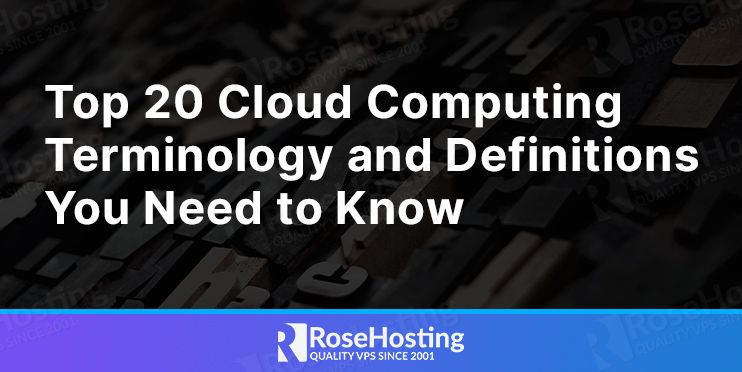
In this blog post, we are going to explain the terminologies and definitions related the Cloud Computing.
You will ask yourself first, what is Cloud Computing and what is the meaning and use of that. Of course, we are here to introduce you more to this. Cloud computing is the on-demand availability of computer systems of resources like data storage, CPU power, databases, networking, software and etc. Cloud computing offers very scalable and flexible solutions for customer needs, which may reduce the costs, or increase them for some unaware users.
In the next paragraphs, we will explain the meaning of the most important terminologies and their definitions related to Cloud Computing. Let’s get started!
Table of Contents
1. Infrastucture as a Service (IaaS)
IaaS is a model of cloud computing that provides virtualized resources such as data storage, network, and CPU power to the user as a service over the internet. Users have access to their virtual machines and can start, stop and modify the services on their own on the server.
2. Platform as a Service (PaaS)
Paas is a model of cloud computing in which the resources to the user are provided by the vendor (third-party provider). The hardware and software are hosted on the PaaS infrastructure. With this model users are paying on a per-user basis.
3. Software as a service (SaaS)
Software as a service is a model of cloud computing in which the resources to the user are provided by the vendor and are available over the network and the users are gain access to the software and databases.
4. Private Cloud
A private cloud is a cloud infrastructure accessible only to selected users. It is provisioned for use by a single organization instead of the general public. Private Cloud offers flexibility, scalability, self-service, and many customizable features.
5. Public Cloud
Opposite of the Private Cloud is the Public Cloud as a cloud infrastructure accessible for all users over the internet. Public Cloud also provides flexibility, scalability, and pay-per-use. The Public Cloud can be safe as the Private Cloud if it is implemented correctly with the right security methods.
6. Managed Cloud
Managed Cloud or Managed Service Provider is an IT service provider, that allows customers to deploy cloud-based services. In the cloud base services we can mention the IaaS, PaaS, and SaaS, network as well and the application and system services. These services are provided across a network to clients.
7. Hybrid Cloud
This type of Cloud is a mix of public, private, and on-premises solutions. Hybrid Cloud is a solution that main goal is to create an automated, flexible, scalable environment with costs better than the Public and Private Cloud. Hybrid Cloud offers the best from the Public and Private Cloud together.
8. Multi Cloud
This type of cloud is composed of multiple cloud service providers. Its usage is a combination of Public Cloud, Private Cloud, or the cloud that offers both of them as known as Hybrid Cloud. The Multi-Cloud is suitable when users want a cloud provider for certain services such as Public Cloud and different cloud providers for data storage for example.
In these 8 paragraphs we tried to explain a bit more about models of cloud computing (IaaS, PaaS, and SaaS) and the types of clouds, public, private and etc. In the next few paragraphs, we are going to explain the hardware parts related to cloud computing.
9. Host Machine
A Host machine is a physical hardware that hosts multiple virtual private servers-machines. Each Host machine includes a processor, memory, network connection, hard drive, and operating system (OS). A combination of these will make programs and applications run smoothly for the customers.
10. Central Processor Unit – CPU
An electronic chip that executes instructions by the programs and applications running on the server is called Centra Processor Unit or simply CPU. The generation the, power of CPU, and the number of the Cores are the most important for the application performances. In cloud computing, you will often see the word vCPU which means a virtual central processor unit.
11. Random Access Memory – RAM
A Random Access Memory is responsible for storing the information running on the server temporarily. The information stored in the RAM can be accessed very fast from everywhere on the server and the CPU will not have to search the information on the hard drive every time when required. The RAM is much faster than the HDD or SSD.
12. Hard drive
The Hard drives are responsible for storing the data. The hard drives on the servers can be SSD or NVMe. The NVMe is much faster than SSD, and the difference can be noticed by comparing tests for website load time.
These paragraphs were more about the parts of the Host Machine. In the next paragraphs, we will explain some new things that cloud computing offers, unlike traditional hosting.
13. Scalability and Elasticity
Scalability is a very big advantage in cloud computing which can handle the growing workload. It can increase the resources on application demand and can be a main factor of the cost efficiencies at the end of the month for the user. Elasticity as well can make the provisioned resources match the current demand as well as possible.
14. Load Balancing
Load Balancing is the ability to distribute the web requests to multiple servers at the point when one server is not able to handle all incoming traffic. The more load balancers are better for very big applications that have thousands of requests every single minute.
15. Replication
Replication is a process of sharing the resources across the cloud infrastructure such as servers or data storage, for better availability, reliability of the applications, database systems, data, or systems.
16. Snapshot
A Snapshot is an instant copy of a live environment made for future recovery if something goes wrong with the application. Also, snapshots are taken for testing development purposes before something new has to be released in the production environment. With snapshots, you can easily restore the data to the environment in no time.
17. Database
A Database is a collection of data organized in separate tables for better querying and accessibility.
18. Database Migration
A process of moving the data between different storage systems or servers is called database migration.
19. Content Delivery Network (CDN)
The content delivery network security protection offers a broad range of protections against attacks such as DDoS, hacking, or spam submitted to the website. Also, the CDN can mitigate the slow network connection.
20. Cloud Marketplace
Cloud Marketplace is an online marketplace that the cloud hosting provider operates with. The customers can subscribe and order applications according to their needs. Feel free to sign up for our managed cloud hosting services at RoseHosting Cloud and take a look at our marketplace.

That’s all! In this tutorial, you learned the most used terminologies in Cloud Computing. If you have difficulties understanding some specific definitions, feel free to sign up for our managed cloud service and contact our technical support anytime you want. We are available 24/7.
If you liked this post about the top 20 cloud computing terminology and definitions, please share it with your friends on the social networks using the buttons on the left or simply leave a reply below. Thanks.